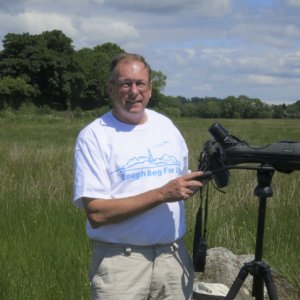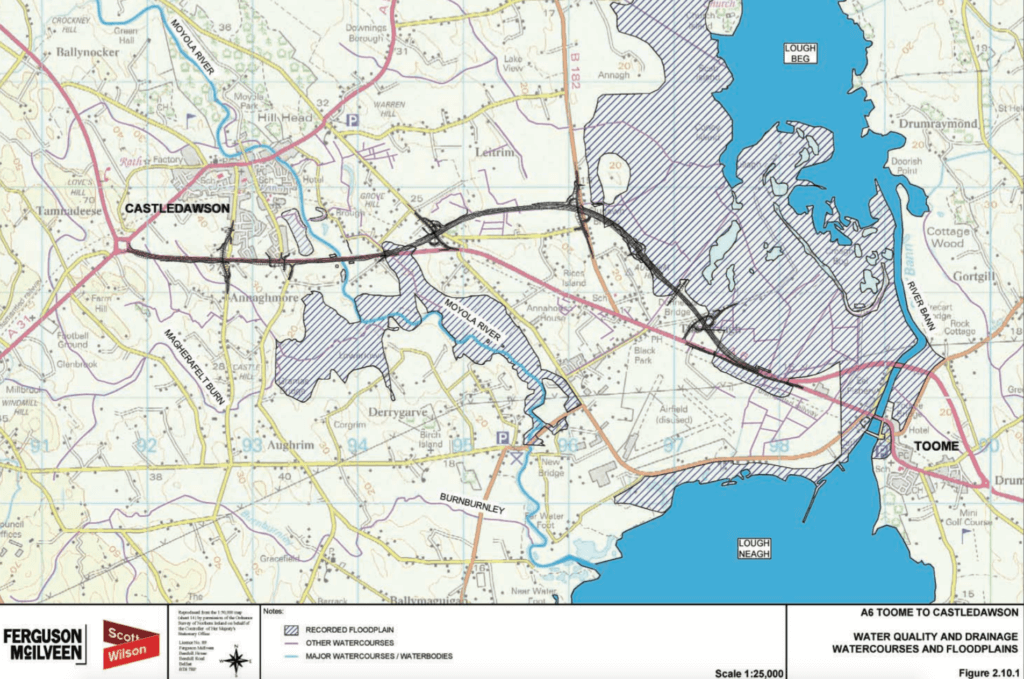 Chris Murphy has lived in Northern Ireland since arriving on the ferry from Liverpool in 1984 as the RSPB’s first, and last, Assistant Regional Officer. Together with his German wife, Doris, he’s known to shout HALT! when special places are threatened like the Belfast Harbour Pools and the Bog Meadows – once zoned for development, now nature reserves. He presently chairs two awareness-raising groups: Lecale Conservation where he lives in County Down and Lough Beg for Life.
Chris Murphy has lived in Northern Ireland since arriving on the ferry from Liverpool in 1984 as the RSPB’s first, and last, Assistant Regional Officer. Together with his German wife, Doris, he’s known to shout HALT! when special places are threatened like the Belfast Harbour Pools and the Bog Meadows – once zoned for development, now nature reserves. He presently chairs two awareness-raising groups: Lecale Conservation where he lives in County Down and Lough Beg for Life.
His previous guest blog was Saving Loughs Neagh and Beg, 6 December 2016. Here he returns to the subject.
UK’s largest freshwater wetland is at the gates of the Supreme Court
The Environmental Audit Committee, one of the House of Commons Select Committees, pondered in January this year over the Birds and Habitats Directives. It warned that Brexit could have potentially far-reaching negative consequences for the UK’s biodiversity.
Step into the picture Environment Minister Michael Gove. In his speech in July titled The Unfrozen Moment – Delivering a Green Brexit he stated that he has ‘no intention of weakening the environmental protections that we have put in place while in the European Union’.
Is the UK’s largest EU designated freshwater wetland, Loughs Neagh & Beg in Northern Ireland, destined to be a practical example of the situation the Select Committee pondered on? Loughs Neagh & Beg, totalling 41,188 hectares in size, was listed in 1976 under the Ramsar Convention as a wetland of international importance and in 1998, under the Birds and Habitats Directives, as a Special Protection Area (SPA). I began legal action in August last year in an attempt to quash a decision to route a section of the upgraded A6 dual carriageway through a part of the Natura 2000 wetland known as the Toome Complex. This is at the heart of Ireland’s single most important Whooper Swan wintering, staging and breeding site and the third most important in the UK. These swan fields are centred on the Creagh Meadows (Creagh is pronounced locally as ‘crake’), which also happen to be part of the Lough Beg landscape made famous by poet laureate Seamus Heaney. The Judicial Review having progressed through Northern Ireland’s High Court and Court of Appeal is now on the threshold of heading to the Supreme Court in London.

Work on the contested section of the road has been suspended since the end of September to the beginning of April to avoid disturbance to hundreds of overwintering Whooper Swans, one of the SPA’s selection features. While my legal challenge is concerned with the integrity of the whole SPA one habitat in particular, lowland wet grassland, which is the preferred habitat of swans, geese and some wading birds such as Golden Plover and Lapwing stands to be affected most. The total amount of wet grassland protected within the SPA equates to just 0.37%. This habitat is used by internationally important numbers of birds for foraging and grazing. The BTO has issued 16 site specific Red (High) Alerts and 12 Amber Alerts for 18 of the 21 SPA selection species that have been evaluated. There is insufficient count data to assess the impact of the scheme on the site’s significant population of Icelandic Greylag Geese.
In June Friends of the Earth Northern Ireland won a separate challenge in the Court of Appeal over unregulated sand extraction from the bed of Lough Neagh, yet this extraction continues unabated and unregulated without a Northern Ireland Executive in place to implement the court’s directions to issue a stop notice.
FoE are alone among leading environmental NGOs in actively working to protect Loughs Neagh & Beg from irreparable damage and have successfully highlighted the legal importance of the Habitats Directive’s ‘Precautionary Principle’.
Against this backdrop of large-scale impacts, including a major Tributyltin oxide pollution incident, peak mid-winter totals of c.100,000 waterbirds in the 1980s and ’90s have declined dramatically; last winter fewer than 39,000 waterbirds were counted. This sharp decline is indicative of unsustainable pressures that conflict with the objectives of the EU Birds and Habitats Directives, the Ramsar Convention’s goal for the wise use of wetlands and the aims of many other international conservation treaties to which the UK is bound.
At the heart of the legal challenge is an announcement made by Northern Ireland’s Minister for the Department for Infrastructure in August 2016 which included the formal adoption of the Statement to Inform an Appropriate Assessment (SIAA) as the Department’s own Appropriate Assessment in compliance with Article 6(3) of the Habitats Directive.
The Department for Infrastructure is also the Competent Authority under the Habitats Directive, making this public body the regulator, promoter, developer, assessor and decision maker – effectively adjudicating in its own court. Murphy maintains that consultation advice from Northern Ireland’s statutory nature conservation body during the route selection process was ignored: “Article 6(3) creates an entirely stand-alone duty and is subject to a high standard of rigour in terms of the inputs and outputs of the process. Adverse impacts were identified under Article 6(3) for this road section that cannot be avoided and therefore not mitigated. The statutory advice to the Department was that the measures proposed to offset Likely Adverse Impacts were compensatory and that the contested route selection could lawfully only proceed subject to the significant hurdle of Article 6(4).”
The EU provides the UK with key environmental protections such as the Birds and Habitats Directives, which have been transposed in England and the devolved regions into local law; in the case of Northern Ireland the Conservation (Natural Habitats, etc) Regulations (NI) 1995. Is it enough to copy EU legislation into UK law when there is neither the will nor the means to enforce it?
In court the Competent Authority described this internationally important wetland as a ‘deficiency’. RSPB and WWT are both assisting this Competent Authority by promoting an academic study of the road’s impact on this discreet, site-faithful population and by sitting on its Whooper Swan Working Group rather than resisting the site’s further fragmentation, degradation and disturbance. A sea change is needed in our attitudes towards protecting the integrity of this and other Natura 2000 sites.

Great blog and great work to try to protect a very important wetland.
I believe that Gove has been downright dishonest when he’s been saying nice things about the environment (such as having ‘no intention of weakening the environmental protections that we have put in place while in the European Union’). As Mark has said we should judge him by his actions and the evidence so far -in the form of the EU withdrawal bill- is that he wants to remove the precautionary principle, the polluter pays principle and any means of ensuring that the protections for sites can be enforced.
See: https://www.theguardian.com/environment/2017/oct/17/uk-withdrawal-bill-rips-the-heart-out-of-environmental-law-say-campaigners
But in the EU, if the unelected Commission refuses you leave to present your environmental case to the European Court, you have no right of appeal.
Hi Mark. Wonder if you can help me. Have not been happy with response from Mid Ulster Council. Heads and brick walls come to mind. Here’s why. An area of bog land bordering the Drumlamph Road near Castledawson/Bellaghy (by my calculations) about 28 hectares, has been subject to tree felling and digger work in the preparation of roadways and drainage channels. I have spoken to the man undertaking the work and he told me he intends to cut peat. At first I thought it was going to be small scale but now the evidence indicates something much more extensive. Realising that planning permission is required for commercial peat extraction I visited the planners in Magherafelt last Friday 23rd March. I was told that no intervention was possible until actual peat extraction was started. This concerned me because the new drainage channels are doing what they are supposed to do and lowering the water table. I don’t know how long this process can continue before it becomes irreversible so I emailed the CEO of Mid Ulster Council and put my argument to him. I have also sent him photos recording some of the effects of digger activity. I asked if some form of prohibition order or injunction could be applied pending due process and adjudication but I have received no acknowledgment or reply. Given the most recent Environmental legislation that came into effect May 2017, is there a way to 1) halt any further action on the bog, and 2) force an evaluation of the merits of the works intended and hear argument for leaving things as they are? The bog has been cut over in the past but to my knowledge has not been worked on for the last 20 years except for some very small scale hand cutting one year. However last year sometime in late May or into June it was set on fire. With hindsight, this was a harbinger of what has recently taken place. I look forward to hearing from you. Best wishes. Michael